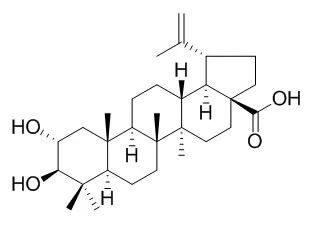| Description: |
Alphitolic acid is a potent Hh/GLI signaling inhibitor, it shows an important relationship between Hh/GLI signaling inhibition, the decrease of BCL2, and cytotoxicity against cancer cells. Alphitolic acid has anti-inflammatory, antitumour, and antimicrobial activities, it can suppress the proliferation of SCC4 and SCC2095 OSCC cells with IC50 values of 12 and 15 uM, respectively, via apoptotic induction, this drug effect on apoptosis is, in part, associated with its ability to block Akt-NF-κB signalling; it could as an ingredient in functional food/dietary supplement for OSCC prevention.
|
| In vitro: |
| Food Res. Int., 2015, 77(2):109-17. | | Quali-quantitative determination of triterpenic acids of Ziziphus jujuba fruits and evaluation of their capability to interfere in macrophages activation inhibiting NO release and iNOS expression.[Reference: WebLink] | Ziziphus jujuba Mill fruits are recognized as an outstanding source of biologically active compounds including triterpenic acids. In order to evaluate the triterpenic profile of these edible and little commercial fruits and to contribute to the improvement of their potential value as food, a quali-quantitative study along with biological assays were carried out.
METHODS AND RESULTS:
The phytochemical investigation of the triterpenic fraction yielded nine triterpenic acids, ceanothic acid (1), Alphitolic acid (2), maslinic acid (3), 3- O-cis-coumaroyl Alphitolic acid (4), 3- O-trans-coumaroyl Alphitolic acid (5), 3- O-trans-coumaroyl maslinic acid (6), 3- O-cis-coumaroyl maslinic acid (7), betulinic acid (8), and oleanolic acid (9). In order to perform the quantitative determination of compounds 1- 9 in Z. jujuba fruits, an analytical method based on liquid chromatography coupled to mass spectrometry with ESI source and triple quadrupole analyzer (LC-ESI(QqQ)MS), using the very sensitive and selective mass tandem experiment called Multiple Reaction Monitoring (MRM), was developed and validated.Furthermore, the antiproliferative activity of compounds 1- 9 was determined on three different cultured cell lines, namely J774A.1, MCF7 and A459 cells.
CONCLUSIONS:
For compounds 1, 2, 5 and 9, exhibiting no significant antiproliferative activity, the effects on nitrite production by LPS-stimulated J774.A1 cultured macrophages were evaluated (10-100. μM), showing the ability of Alphitolic acid (2), and 3- O-trans-coumaroyl Alphitolic acid (5) to reduce significantly (P. <. 0.001) and in a concentration related manner NO production. The capability of compounds 2 and 5 to influence the expression of the inducible nitric oxide synthase (iNOS) was also investigated, showing that both compounds reduced iNOS expression in a concentration related manner. | | Planta Med. 2000 Dec;66(8):768-9. | | Antimicrobial triterpenoids from Licania heteromorpha.[Pubmed: 11199141 ] |
METHODS AND RESULTS:
Six triterpenoids having a lupane and oleane skeleton were isolated from the leaves and young branches of Licania heteromorpha Bentham var. heteromorpha and were identified as: betulinic acid 1, Alphitolic acid 2, 3 beta-O-trans-p-coumaroyl Alphitolic acid 3, 3 beta-O-cis-p-coumaroyl Alphitolic acid 4, 3 beta-O-trans-p-coumaroyl maslinic acid 5, 3 beta-O-cis-p-coumaroyl maslinic acid 6. The antimicrobial activity of these compounds was evaluated in vitro on clinically isolated microorganisms employing a microdilution method.
CONCLUSIONS:
Compounds 2, 3, 5, and 6 showed antimicrobial activity on Gram-positive bacteria and yeasts, whereas none of the six triterpenoids were active against Gram-negative organisms. |
|






 Cell. 2018 Jan 11;172(1-2):249-261.e12. doi: 10.1016/j.cell.2017.12.019.IF=36.216(2019)
Cell. 2018 Jan 11;172(1-2):249-261.e12. doi: 10.1016/j.cell.2017.12.019.IF=36.216(2019) Cell Metab. 2020 Mar 3;31(3):534-548.e5. doi: 10.1016/j.cmet.2020.01.002.IF=22.415(2019)
Cell Metab. 2020 Mar 3;31(3):534-548.e5. doi: 10.1016/j.cmet.2020.01.002.IF=22.415(2019) Mol Cell. 2017 Nov 16;68(4):673-685.e6. doi: 10.1016/j.molcel.2017.10.022.IF=14.548(2019)
Mol Cell. 2017 Nov 16;68(4):673-685.e6. doi: 10.1016/j.molcel.2017.10.022.IF=14.548(2019)